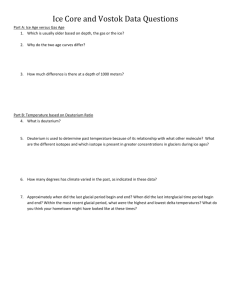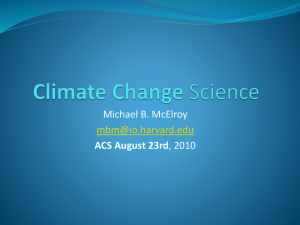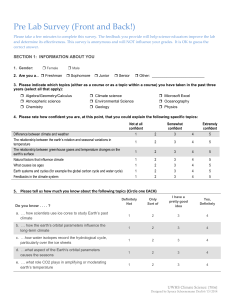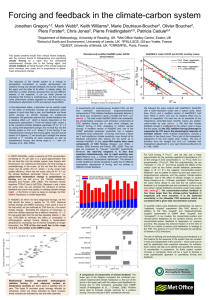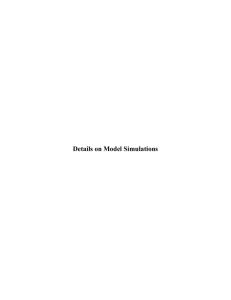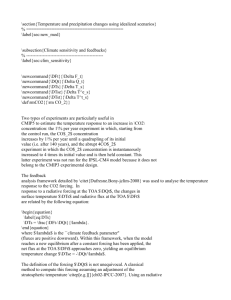Student Handout for CO2 Feedback
advertisement
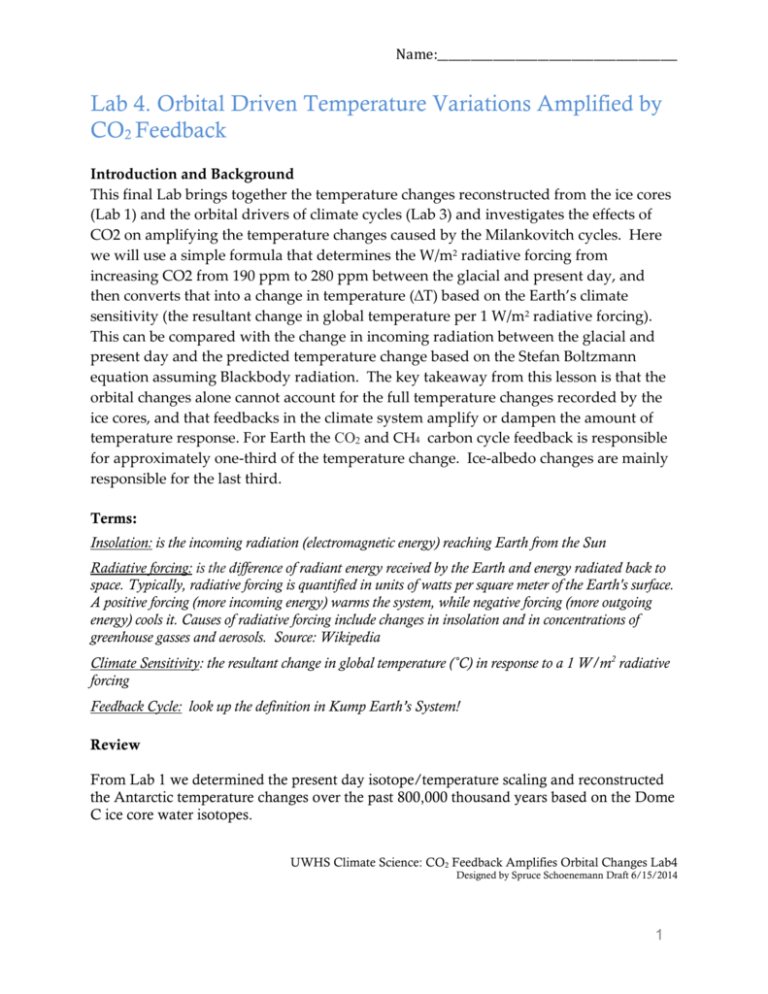
Name:___________________________________________ Lab 4. Orbital Driven Temperature Variations Amplified by CO2 Feedback Introduction and Background This final Lab brings together the temperature changes reconstructed from the ice cores (Lab 1) and the orbital drivers of climate cycles (Lab 3) and investigates the effects of CO2 on amplifying the temperature changes caused by the Milankovitch cycles. Here we will use a simple formula that determines the W/m2 radiative forcing from increasing CO2 from 190 ppm to 280 ppm between the glacial and present day, and then converts that into a change in temperature (∆T) based on the Earth’s climate sensitivity (the resultant change in global temperature per 1 W/m2 radiative forcing). This can be compared with the change in incoming radiation between the glacial and present day and the predicted temperature change based on the Stefan Boltzmann equation assuming Blackbody radiation. The key takeaway from this lesson is that the orbital changes alone cannot account for the full temperature changes recorded by the ice cores, and that feedbacks in the climate system amplify or dampen the amount of temperature response. For Earth the CO2 and CH4 carbon cycle feedback is responsible for approximately one-third of the temperature change. Ice-albedo changes are mainly responsible for the last third. Terms: Insolation: is the incoming radiation (electromagnetic energy) reaching Earth from the Sun Radiative forcing: is the difference of radiant energy received by the Earth and energy radiated back to space. Typically, radiative forcing is quantified in units of watts per square meter of the Earth's surface. A positive forcing (more incoming energy) warms the system, while negative forcing (more outgoing energy) cools it. Causes of radiative forcing include changes in insolation and in concentrations of greenhouse gasses and aerosols. Source: Wikipedia Climate Sensitivity: the resultant change in global temperature (˚C) in response to a 1 W/m2 radiative forcing Feedback Cycle: look up the definition in Kump Earth’s System! Review From Lab 1 we determined the present day isotope/temperature scaling and reconstructed the Antarctic temperature changes over the past 800,000 thousand years based on the Dome C ice core water isotopes. UWHS Climate Science: CO2 Feedback Amplifies Orbital Changes Lab4 Designed by Spruce Schoenemann Draft 6/15/2014 1 Name:___________________________________________ 1. What was the average magnitude of the temperature change between the glacial periods and interglacial periods from your isotope reconstruction? We discussed how the Earth’s orbital configuration (Milankovitch cycles) was the primary driver of the millennial scale climate cycles recorded by the ice cores. Although the orbital changes explain the timing and direction of variations observed in the ice cores, the magnitude of insolation (radiative forcing in W/m2) change is too small to explain the full temperature response observed in the ice cores. In fact the changes in radiation can account for only about a third of the temperature changes. 2. What other components of the climate system could be sensitive to the orbital forcing changes and amplify the Earth’s temperature response? The goal of this lab is to investigate the effect of glacial to interglacial changes in CO2 concentrations on the Earth’s energy balance. To do this, you will estimate the CO2 contribution of warming during the last deglaciation (21,000 to 12,000 years ago), and determine how much the CO2 changes the reconstructed temperatures and the amount of radiative forcing (incoming energy) change caused by the Milankovitch cycles. We will see that the influence of green house gas concentrations (in this case CO2) is to amplify the orbitally driven temperature changes. Step 1: Determine the radiative forcing (in W/m2) difference between the glacial and interglacial caused by the different orbital configuration (Milankovitch Cycles) Instructions: Use the Excel Spreadsheet and formulas provided for this Lab. 1. Calculate the Earth’s present-day global average temperature using the blackbody approximation and the Stefan Boltzmann equation. 𝑇𝑔 = (𝑆𝑜 ∗ (1 − 𝐴)/(4𝜎))1/4 where Tg = ground temp, So = incoming radiation, A = albedo (0.3), and 𝜎 = 5.67 x 10-8 Assume the incoming radiation from the Sun reaching the Earth is 1365 (W/m2) at 65˚N. Your answer will be in Kelvin. Enter the answer into the Excel document. UWHS Climate Science: CO2 Feedback Amplifies Orbital Changes Lab4 Designed by Spruce Schoenemann Draft 6/15/2014 2 Name:___________________________________________ 2. Do the same for the Earth’s global average temperature at the Last Glacial Maximum (LGM) (21,000 yr ago). Assume the incoming radiation is 1330 (W/m2) at 65˚N. Enter the answer in the Excel document. 3. Now calculate the temperature difference (in ˚C). This is the amount of temperature change that would be expected due to changes in the Earth’s orbital configuration assuming no greenhouse effect or ice-albedo. Enter this value into the orange box in the Excel document. 4. How does the temperature change you calculated above compare to the reconstructed temperature change from the ice core record in Lab1? State one important difference between what these two temperatures represent. Step 2: Determine the amount of radiative forcing caused by the change in CO2 concentration from the LGM to the end of the deglaciation. 1. Use the following equation to calculate the global radiative forcing (W/m2) for the original CO2 concentration (190 ppm) and the end of the deglaciation (280 ppm). Enter this value into the blue box in the Excel document. 𝑅𝐹𝐶𝑂2 = 5.35 × 𝐿𝑁 (𝐶𝑂2𝑓𝑖𝑛𝑎𝑙 ) (𝐶𝑂2 𝑜𝑟𝑖𝑔 ) Step 3: Determine the change in global average temperature due to the RF you calculated above. To do this, you need to use the following relationship, ∆T = RF/alpha, where alpha is the Earth’s climate sensitivity. Use the conservative alpha value of 0.77 ˚C per W/m2 determined from climate models and paleoclimate data. Enter this value into the yellow box in the Excel document. 1. How does the temperature change caused by the CO2 concentrations (yellow box) compare to the orbitally driven temperature change (orange box)? Approximately how many times larger is the CO2 temperature driven change? 2. What are the other two major greenhouse gases that contribute to amplifying the orbitally driven changes? What are the names of these feedback cycles? UWHS Climate Science: CO2 Feedback Amplifies Orbital Changes Lab4 Designed by Spruce Schoenemann Draft 6/15/2014 3 Name:___________________________________________ Takeaway 1. Summarize in your own words what you have learned about what controls the millennial-scale climate variations preserved in the ice core records and how that signal is amplified by feedback cycles within the Earth’s climate system. 2. During the glacial to interglacial periods, how do you think the Earth’s surface albedo (reflectivity) changed and what effect would that have on the global average temperature? Hint: Think back to the Stefan-Boltzmann equation and Earth’s surface albedo. 3. Explain how changes in the Earth’s surface albedo are either a positive or negative feedback. 4. Is the Dome C ice core temperature reconstruction a reflection of regional or global temperature change, or both? Explain your answer in terms of the water isotopes, GHGs, ice albedo, and orbital forcing. What other paleoclimate proxies might help you verify whether the ice core signal is global or regional? 5. How could you obtain greater confidence in your temperature reconstruction for Antarctica? 6. Use the same equation in problem 1 and calculate the radiative forcing and expected temperature change caused by the anthropogenic contribution of CO2 since the PreIndustrial (1750 AD) (280 ppm) to today (402 ppm). How does the magnitude of this temperature change compare to the glacial-interglacial change? UWHS Climate Science: CO2 Feedback Amplifies Orbital Changes Lab4 Designed by Spruce Schoenemann Draft 6/15/2014 4
